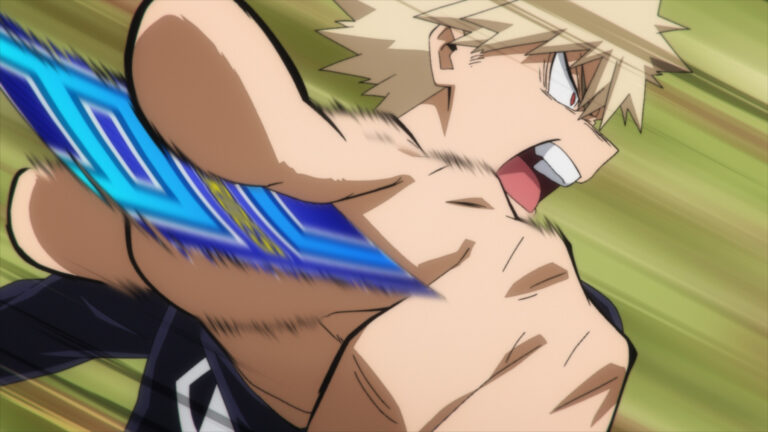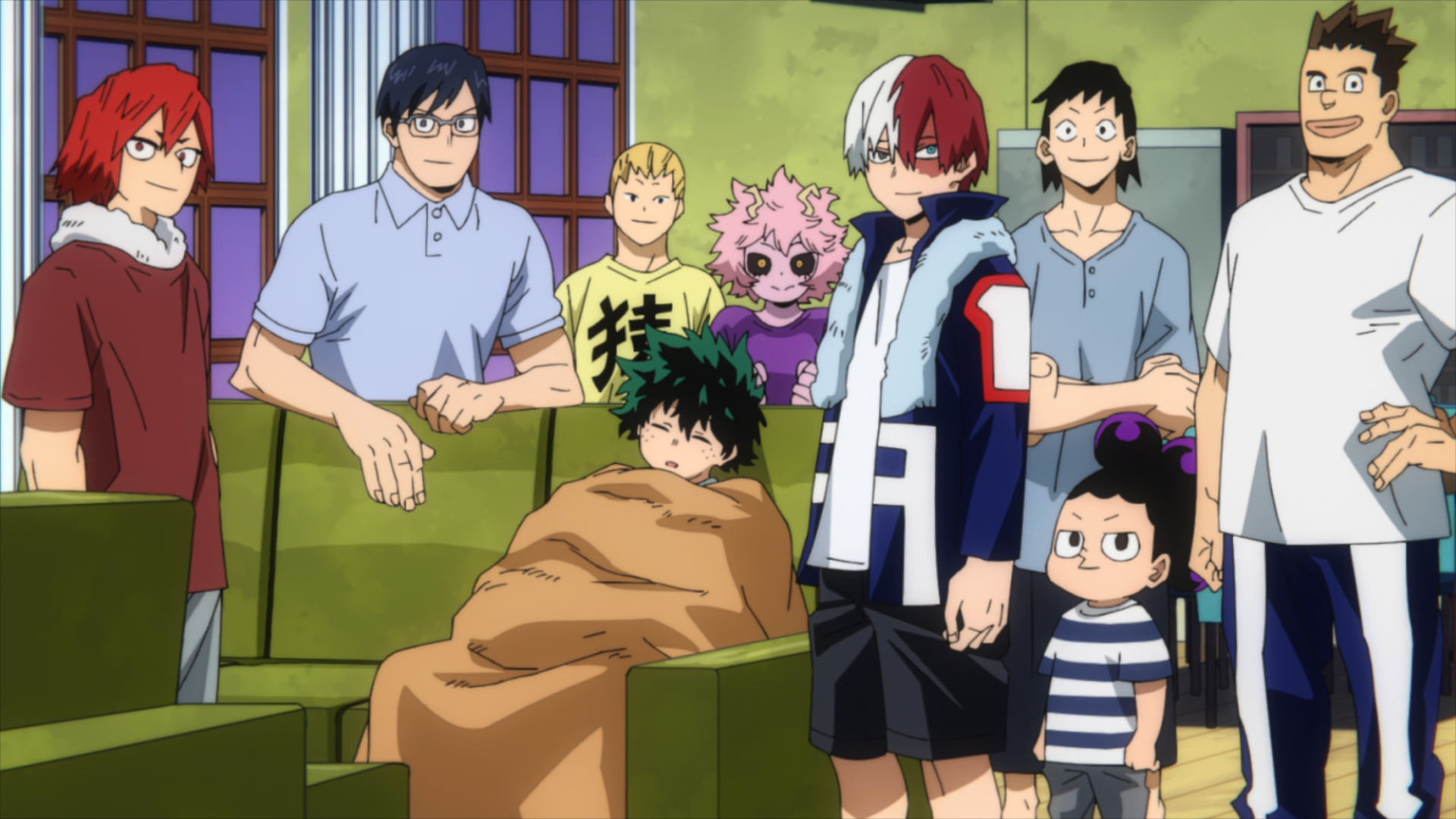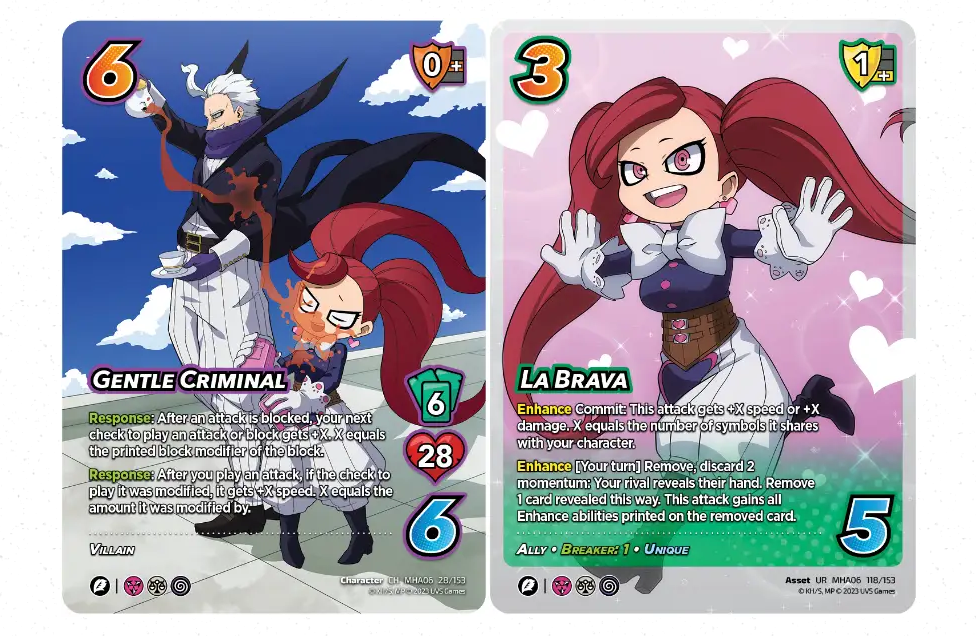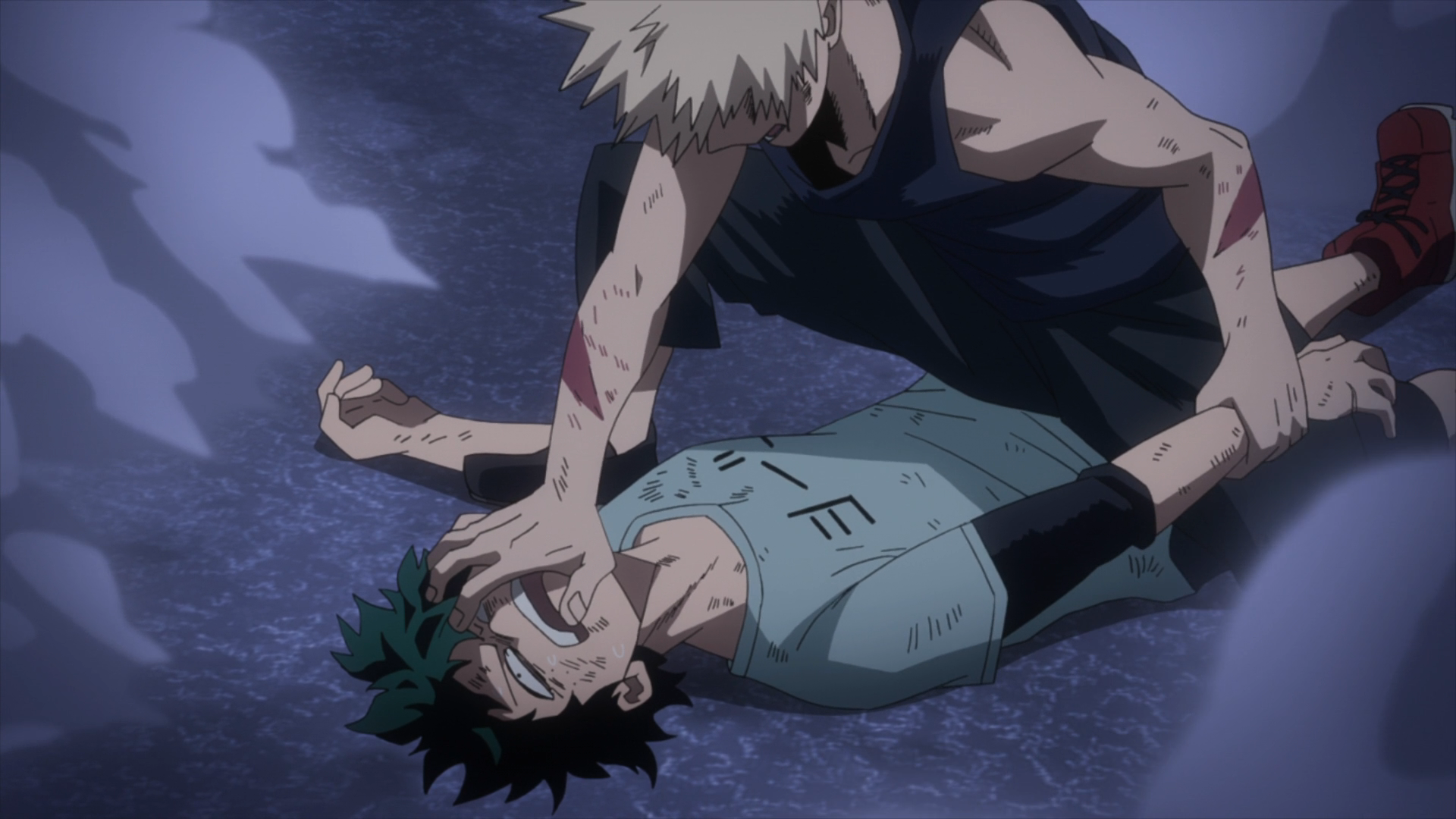My Hero Academia premiered its season 6 anime original episode for the first time ever at New York Comic Con. The episode, titled “My Hero Academia: UA Heroes Battle,” features the introduction of a unique card game with each card being based on a My Hero Academia character. Within the episode Class 1-A tries their hand at this card game, leading to a lot of hijinks and giving the audience a narrative-driven tutorial on how the game works and what kinds of strategies can be employed to win.
This card game is, predictably, something that corresponds to real, playable cards. Interestingly, before getting into the finer details of the episode, the real card game and the card game in the episode are incredibly different in a lot of major ways. The real-life card game comes from a company called UVS Games and its multi-IP card game the Universus Collectible Card Game (CCG). Personally, I hadn’t ever heard of this until doing some research after the episode. Judging by the crowd’s reaction, I think many people, myself included, took this episode and the showcasing of cards around it as the announcement of a new, My Hero Academia standalone card game. There was an entire presentation prior to the actual episode where the cards were shown off and some examples flashed on screen. This created a weird situation where, by virtue of trying to condense the game into something that could be explained in a few minutes, this episode showed a version of the game that made me not want to play it. I felt like it failed to achieve its primary purpose. To me, the only strong moment in the entire episode came in the final few minutes after 20 minutes of hijinks and prolonged dialogue. Let’s talk about it.
Spoilers ahead for My Hero Academia: UA Heroes Battle
The Setup
The premise of the episode is relatively straightforward. Class 1-A is cooped up inside the dorms during winter break, forbidden to go outside due to their being hunted down by the League of Villains. The only time they’ll get to spend with their families will be brief and under the supervision of a pro hero who will escort them to their home and then right back. The first few minutes of the episode have the students (mostly Denki and Mineta) lamenting their experience before being scolded for an obnoxiously long time by Ida and Yaoyorozu. Typically in My Hero Academia, these sequences that take place in the dorms are actually pretty nice, especially when they give us a look into the would-be home lives of all the students rather than only showing them in the classroom. It also gives them a natural place to discuss things that are troubling them, providing niche hints and segues into future events. In this case though, because the episode started with it and has a standalone plot, the long dialogue felt like filler within filler. I understand that Yaoyorozu and Ida have the tendency to be the “parents” of the class but even they don’t actually rant endlessly.
Partway through this, Mirio arrives in an admittedly hilarious way by going into a snowman, dragging said snowman into the dorms, and then flexing so hard that the snow flies into the faces of class 1-A. He introduces the card game as a sort of consolation prize for the class not being able to go to the school’s annual New Year’s festivities before quickly leaving (kinda weird that the game is so fun but you don’t stay to play it). Along with the cards, Mirio provides the class with a hologram display board of sorts. The cards in the episode have no text on them, only pictures, so the board is needed in order to detect the card and then apply relevant effects. The effects in this case are versions of the cards’ characters projected onto a holographic battle arena. To try and give this an image, think of the Battle City hologram technology used in Yu-Gi-Oh! but on top of a small mechanical tablet that projects images atop its surface. Mei designed this little arena system and a hologram of her explains the rules while a virtual Present Mic serves as an MC of sorts.
A Horrible Card Game — And Not Even the Real One
Here are the rules of the card game within the episode. Each character has a deck of cards featuring various My Hero Academia students and teachers. These cards come in two types: regular cards are just characters (usually students) while EX cards are teachers and/or pro heroes. Each of the two players picks three cards and the game begins. Each round both players select a card of their choice and place it on the device. The device (using AI, because sure) renders a battle between the cards’ characters. Cards can seemingly accumulate damage that stays between rounds, such as Denki shocking himself and being basically unable to fight the round afterward. If a character is killed, rendered incapacitated, or pushed out of the arena’s bounds, it is eliminated, and the winning card stays. The player who lost a card must place a new one and this continues until all of one player’s cards have been defeated. As an aside, this doesn’t seem like a game that needs AI at all. There are a finite number of cards and therefore a finite number of battles that could just be scripted, but I digress.
This game design is…very bad. I’m actually glad it isn’t how the real game works, but because I don’t have an official ruleset to compare to as I watch I walked away thinking of these rules as the actual rules. The first matchup in a round is more or less down to luck if you use a normal card and probably an auto-win if you use a special card. No one ever used more than one of the special / EX cards so I’m assuming you’re limited to one per game. That being said, since the only time you can strategize around your opponent’s cards is after you lose a card and are playing a new one, and since a small selection of cards are just win buttons against others (Todoroki, for example, just instantly freezes his opponent into ice and most students can’t handle that), it seems like the dominant strategy is always to play your special card (like All Might), force your opponent to use their special card to beat your semi fatigued one, and then just trade rounds until you win since your opponent lost a card first (basically win, lose, win, lose, win –> win the match).
In the actual game, you do play as a character card, but that card is used to determine your maximum health, hand size, and other aspects of your deck. That card itself doesn’t attack; there are dedicated Attack Cards that are used to battle and Foundation Cards that function sort of like land cards in Magic: the Gathering. Very much a different game.
The Single Good Moment
The moment that stuck out most to me and offered the strongest narrative oomph of the episode comes when Bakugo arrives (he’d been asleep the entire episode) and challenges Midoriya to a battle where they both use their own cards. This is very interesting; these cards are fighting simulated battles and are both willing and able to fight each other to the death (Mina quite literally melts Mineta at one point). Bakugo and Midoriya have fought one-on-one before. My Hero Academia produced a beautiful episode for this fight, which ended with Midoriya getting pinned to the ground and All Might stopping the fight before it could go further. This battle is an opportunity for both of them to go all out without consequence. These thoughts are echoed by the characters on screen. Both of them wonder to themselves what “version” of their abilities the cards are based on. Both have continuously grown stronger and appear frustrated at the prospect of even their AI-commanded holograms not fighting at full capacity.
During their battle, both comment on the fight in their minds as their holograms trade blows, perfectly and evenly matched. Bakugo thinks to himself that he’d be dodging better than his hologram is and Midoriya notes that his hologram is suffering from habits he’s taken time to eliminate, such as hesitating before charging at someone and missing valuable timing. The fight ultimately ends in a draw because the time limit for the AI-simulated match reached its limit. I felt like this was a pretty cool way to let both of these two comment on their progress and take pride in the mistakes they’ve learned to stop making. In their last battle, and really all the ones prior, Midoriya was trying to prove that he was a worthy successor to All Might and a worthy rival for Bakugo. This time, he knows these things are true and criticizes the game for making him weaker than he really is. For a filler / special episode that sequence did a lot. Ultimately the match ends when both pick a random card, with Bakugo getting All Might and Midoriya getting a literal dog, which All Might tries to return to its owner by jumping out of bounds with it, rendering the match a tie.
My Hero Academia Did Something Weird With This One
I don’t really know what to think about this episode. My Hero Academia is no stranger to devoting episodes to advertising and marketing, especially for the many movies in the series. This episode’s goal is definitely just advertising the card game. That explains the premise. Even more, the episode coincides with the release of an upcoming card set called Jet Burn. On top of this episode getting released at a merch-driven event like New York Comic Con (before it even airs in Japan, mind you), watchers were informed that by buying any Crunchyroll merchandise at the convention you will also receive some cards. To me, this all just means every part of this was meant to push the card game.
Perhaps I’m being a bit harsh because, after all, corporations release products and try to market them all the time. What I especially dislike about this episode and the marketing campaign it represents is that it presented itself as something new and exciting, as if the card game didn’t already exist. But also…the episode wasn’t very good. If something is going to essentially be a long commercial it should at least be solid. I think the best example of how this should be done is something like Super Dragon Ball Heroes. This series is entirely promotional, extremely up-front about it (it has watermarks indicating it’s promotional), and pretty entertaining. The storyline it follows only exists in video and card games and the episodes are brief, usually only 8 minutes long. I feel like “My Hero Academia: UA Heroes Battle,” in contrast, tried to hide its intents and wound up creating an advertisement that makes a real, fun-looking card game seem incredibly bland.
Images via Crunchyroll, UVS Games
© Kohei Horikoshi / Shueisha, My Hero Academia Project




Participate In Discussions